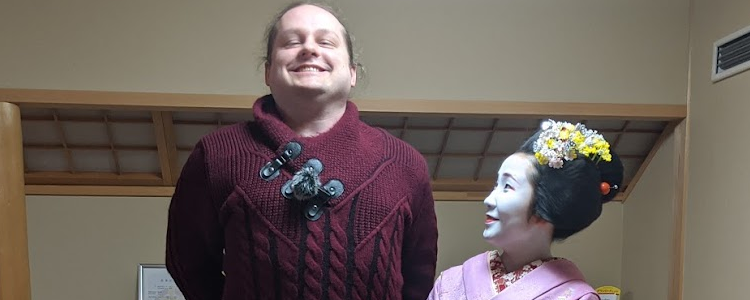Learn more about Japanese culture in the city of Kyoto, which had been the ancient imperial capital of Japan for hundreds of years from 794 to 1868. That’s over 1,000 years of history! It’s famous for numerous classical Buddhist temples, Shinto shrines, gardens, imperial palaces, and rich culture.
See a Geisha or Maiko

Geisha are fabled for their hospitality and performance skills. You can also meet a younger Geisha-in-training, or a Maiko, and possibly even get a private session. Gion, in Southern Higashiyama, looks like a street ripped straight out of an old-time Samurai drama film. The narrow wooden houses on narrow lanes are pretty accurate representations of housing just a couple of generations back. And this area is where you’re most likely to run into a geisha strolling through the street on the way to a client.
Visit a Shrine
With over 400 Shinto shrines in Kyoto, deciding on which shrines to visit can be overwhelming. Each one has its own unique experience and rich history. The Kamigamo Shrine is one of the oldest shrines in the world and has been designated as a UNESCO World Heritage Site.
Kinkakuji Temple
The “golden temple” is a serene and beautiful temple surrounded by a lake and rich greenery. This zen temple is wrapped almost entirely in gold leaf, including in the inside. Kinkakuji Temple was built by a former shogun and promised as a temple after his passing.
Kiyomizu-dera Temple
This beautiful hilltop temple is a UNESCO World Heritage site surrounded by cherry blossoms. Kiyomizu-dera is supposed to be quite a magical place, and has the Jishu Shrine honoring the god of love. You can find true love by visiting this temple.

San-ju-san Gendo Temple
I visit this temple almost every time I am in Kyoto because of the serenity of its interior lake, and its convenient location next to the Kyoto art museum.
The San-ju-san Gendo Temple, also known as the 33 Gendo Temple, is a Buddhist temple located in Tokyo, Japan. The temple is famous for its stunning collection of statues depicting the Bodhisattva Kannon, also known as the Goddess of Mercy, in 33 different forms. These statues, which range in size from just a few centimeters to several meters tall, are considered some of the finest examples of Buddhist art in Japan.
Visitors come to the San-ju-san Gendo Temple to admire the beautiful statues, as well as to experience the peaceful and spiritual atmosphere of the temple. The temple is also known for its beautiful gardens, which are considered some of the finest examples of traditional Japanese garden design. In addition, the temple offers visitors a chance to learn about Buddhist culture and beliefs, and to participate in traditional Buddhist ceremonies and rituals.
In conclusion, the San-ju-san Gendo Temple is a must-visit destination for anyone interested in Japanese culture, art, and spirituality. Its stunning collection of statues, beautiful gardens, and peaceful atmosphere make it an ideal place to escape the hustle and bustle of city life and to experience a sense of inner peace and tranquility.
Walk the “Philosopher’s Path”
Lined with cherry trees, this canal in Northern Higashiyama is a beautiful sight during blossom season in the springtime. The 1 mile path between the Nanzen-ji and Ginkaku-ji temples is perfect for a nice stroll. It’s called the Philosopher’s Path because philosopher Nishida Kitaro (1870-1945) was reported to have strolled the path as part of his daily meditations.
Along the way you can also stop off at several more temples including temple Honen-in. It’s free to stroll the path, but it’s not very close to any train station, though the easiest way to get around Kyoto is by taxi, so it’s encouraged to start at one temple and walk to the next.
Visit the Kyoto International Manga Museum
Kyoto is the cultural heart of Japan, so it makes sense that a ton of manga and anime history exists here. The Kyoto International Manga Museum is the perfect destination for a chilly day in Kyoto. The museum features exhibitions looking at the role of manga in Japanese culture, and the museum has tons and tons of manga and graphic novels to see. It costs less than $10 USD to enter.
Check out the Ninja Museum
I visited the Ninja Museum in Kyoto and found it to be pretty entertaining. It was a really small museum, probably no more than 20 or 30 people could visit at one time. But it was really neat to see some old-fashion ninja clothing and get to practice with rubber ninja throwing weapons. The teacher of the ninja museum was really informative about the history of ninja in Japan.
Ninjas were stealthy warriors in feudal Japan, known for their covert tactics and abilities in espionage and sabotage. They had neat, highly improvised weapons and clothing. They were often hired by feudal lords for their skills in unconventional warfare, and their reputation for being highly skilled and mysterious has made them an enduring part of Japanese culture. The ninja mystique has been romanticized in popular culture and remains an important part of Japanese history and tradition. You’ve heard of Naruto, right? Though Naruto is NOTHING like what real ninja were like.
Tips for Visiting Kyoto
Be warned that during the busy season there are hundreds of thousands of other foreign travelers visiting Kyoto, and everything tends to be crowded. Going in an off season is highly recommended if you want to experience things on a more intimate level.
You can also travel a bit to Arashiyama, which is still in Kyoto, or go South to Osaka.